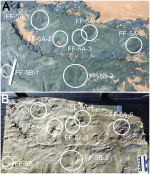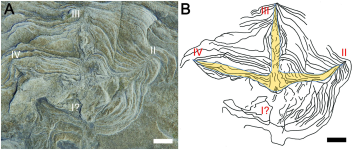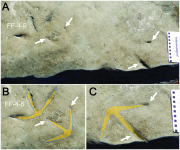Fred Ruhe
Well-known member

Anthony J. MartinI, Melissa Lowery, Michael Hall, Patricia Vickers-Rich, Thomas H. Rich, Claudia I. Serrano-Brañas & Peter Swinkels, 2023
Earliest known Gondwanan bird tracks:Wonthaggi Formation (Early Cretaceous), Victoria, Australia
PLOS ONE. 18 (11). e0293308. doi:10.1371/journal.pone.0293308
Abstract and free pdf: Earliest known Gondwanan bird tracks: Wonthaggi Formation (Early Cretaceous), Victoria, Australia
The fossil record for Cretaceous birds in Australia has been limited to rare skeletal material, feathers, and two tracks, a paucity shared with other Gondwanan landmasses. Hence the recent discovery of 27 avian footprints and other traces in the Early Cretaceous (Barremian-Aptian, 128–120 Ma) Wonthaggi Formation of Victoria, Australia amends their previous rarity there, while also confirming the earliest known presence of birds in Australia and the rest of Gondwana. The avian identity of these tracks is verified by their tridactyl forms, thin digits relative to track lengths, wide divarication angles, and sharp claws; three tracks also have hallux imprints. Track forms and sizes indicate a variety of birds as tracemakers, with some among the largest reported from the Early Cretaceous. Although continuous trackways are absent, close spacing and similar alignments of tracks on some bedding planes suggest gregariousness. The occurrence of this avian trace-fossil assemblage in circumpolar fluvial-floodplain facies further implies seasonal behavior, with trackmakers likely leaving their traces on floodplain surfaces during post-thaw summers.
Enjoy,
Fred
Earliest known Gondwanan bird tracks:Wonthaggi Formation (Early Cretaceous), Victoria, Australia
PLOS ONE. 18 (11). e0293308. doi:10.1371/journal.pone.0293308
Abstract and free pdf: Earliest known Gondwanan bird tracks: Wonthaggi Formation (Early Cretaceous), Victoria, Australia
The fossil record for Cretaceous birds in Australia has been limited to rare skeletal material, feathers, and two tracks, a paucity shared with other Gondwanan landmasses. Hence the recent discovery of 27 avian footprints and other traces in the Early Cretaceous (Barremian-Aptian, 128–120 Ma) Wonthaggi Formation of Victoria, Australia amends their previous rarity there, while also confirming the earliest known presence of birds in Australia and the rest of Gondwana. The avian identity of these tracks is verified by their tridactyl forms, thin digits relative to track lengths, wide divarication angles, and sharp claws; three tracks also have hallux imprints. Track forms and sizes indicate a variety of birds as tracemakers, with some among the largest reported from the Early Cretaceous. Although continuous trackways are absent, close spacing and similar alignments of tracks on some bedding planes suggest gregariousness. The occurrence of this avian trace-fossil assemblage in circumpolar fluvial-floodplain facies further implies seasonal behavior, with trackmakers likely leaving their traces on floodplain surfaces during post-thaw summers.
Enjoy,
Fred






